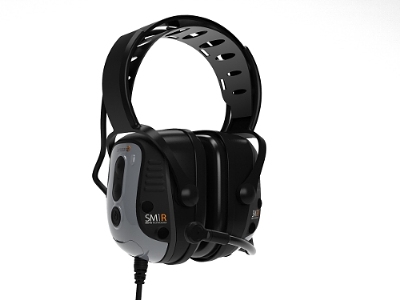by Brianna Crandall — November 23, 2015—Sensear, a U.S.- and Australia-based developer of digital communication headsets, has announced the SM1R, an industrial headset built specifically to enhance two-way radio communication in high-noise environments. The headset is unique from the rest of Sensear’s portfolio in that it contains no battery and instead is powered by the radio, making the unit lighter and more comfortable for the user.

The headset uniquely contains no battery and instead is powered by the radio, making the unit lighter and more comfortable for the user. (Shown: SM1R Headband Version)
Similar to the rest of Sensear’s portfolio, the SM1R headset pairs Sensear’s patented SENS technology and a noise-cancelling boom microphone to allow users in high-noise environments to communicate either face-to-face or via two-way radios while maintaining 360-degree audible awareness of their surroundings and protecting their hearing.
The SM1R will be compatible with many of the most popular radios in the marketplace today from manufacturers such as Motorola, Kenwood, Harris, Hytera, ICOM, Vertex, and Tait, notes the company. Sensear says this is the first product it built specifically for the two-way radio market, using the battery of the radio to power the unit.
Marty Tynan, Sensear VP of Sales, commented:
The SM1R brings Sensear’s innovative SENS technology to another type of customer. It provides them a more affordable option that still protects their hearing and allows them to communicate while retaining situational awareness. This is pivotal for worker safety in all high-noise environments. Hearing an alarm, an encroaching vehicle, or a warning from a nearby coworker can prevent an accident and even save a life.

The headset pairs Sensear’s patented SENS technology and a noise-cancelling boom mic to allow users to communicate while maintaining audible awareness and protecting their hearing. (Shown: SM1R Helmet Version)
The new headset also simplifies the radio system for the end-user by having only one device to charge instead of requiring them to charge a headset and a radio. This is a useful feature for organizations with multiple shifts, such as ground crews at airports, workers in manufacturing plants, and any engineering teams working in noisy environments. Since it is compatible with multiple two-way radios, the SM1R also makes for a suitable rental companion for construction jobs that require temporary use of radio communication.
Sensear is now accepting orders for the SM1R through local two-way radio dealers. The headset is available in headband, behind-the-neck, and helmet versions.




